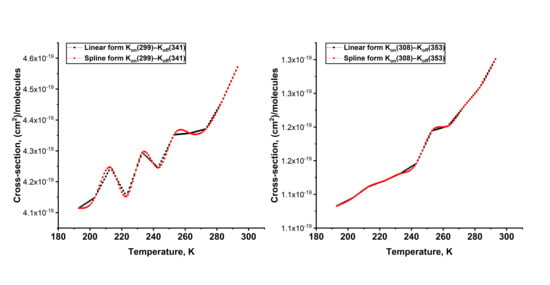Temperature Correction of the Vertical Ozone Distribution Retrieval at the Siberian Lidar Station Using the MetOp and Aura Data
Abstract
:1. Introduction
2. Lidar and Satellite Measurement Instruments
2.1. SLS Ozone DIAL Complex
2.2. Microwave Limb Sounder
2.3. Infrared Atmospheric Sounding Interferometer
3. Measurement Technique
4. Measurement Results and Discussion
5. Conclusions
Author Contributions
Funding
Acknowledgments
Conflicts of Interest
References
- Weitkamp, C. Lidar: Range Resolved Optical Remote Sensing of the Atmosphere; Springer: Berlin/Heidelberg, Germany, 2005; pp. 1–18. [Google Scholar]
- Liu, X.; Chance, K.; Sioris, C.E.; Kurosu, T.P. Impact of using different ozone cross sections on ozone profile retrievals from Global Ozone Monitoring Experiment (GOME) ultraviolet measurements. Atmos. Chem. Phys. 2007, 7, 3571–3578. [Google Scholar] [CrossRef] [Green Version]
- Orphal, J.; Staehelin, J.; Tamminen, J.; Braathen, G.; De Backer, M.-R.; Bais, A.; Balis, D.; Barbe, A.; Bhartia, P.K.; Birk, M.; et al. Absorption cross-sections of ozone in the ultraviolet and visible spectral regions: Status report 2015. J. Mol. Spectrosc. 2016, 327, 105–121. [Google Scholar] [CrossRef] [Green Version]
- Liu, C.; Liu, X.; Chance, K. The impact of using different ozone cross sections on ozone profile retrievals from OMI UV measurements. J. Quant. Spectrosc. Radiat. Transf. 2013, 130, 365–372. [Google Scholar] [CrossRef]
- Lamsal, L.N.; Weber, M.; Tellmann, S.; Burrows, J.P. Ozone column classified climatology of ozone and temperature profiles based on ozonesonde and satellite data. J. Geophys. Res. 2004, 109, D20304. [Google Scholar] [CrossRef]
- Wang, H.; Chai, S.; Tang, X.; Zhou, B.; Bian, J.; Zheng, X.; Vomel, H.; Yu, K.; Wang, W. Application of temperature dependent ozone absorption cross-sections in total ozone retrieval at Kunming and Hohenpeissenberg stations. Atmos. Environ. 2019, 215, 116890. [Google Scholar] [CrossRef]
- Burlakov, V.D.; Dolgii, S.I.; Nevzorov, A.A.; Nevzorov, A.V.; Gridnev, Y.; Kharchenko, O.V. Measurements of Ozone Vertical Profiles in the Upper Troposphere–Stratosphere over Western Siberia by DIAL, MLS, and IASI. Atmosphere 2020, 11, 196. [Google Scholar] [CrossRef] [Green Version]
- Park, C.B.; Nakane, H.; Sugimoto, N.; Matsui, I.; Sasano, Y.; Fujinuma, Y.; Ikeuchi, I.; Kurokawa, J.-I.; Furuhashi, N. Algorithm improvement and validation of National Institute for Environmental Studies ozone differential absorption lidar at the Tsukuba Network for Detection of Stratospheric Change complementary station. Appl. Opt. 2006, 45, 3561–3576. [Google Scholar] [CrossRef]
- Nakazato, M.; Nagai, T.; Sakai, T.; Hirose, Y. Tropospheric ozone differential-absorption lidar using stimulated Raman scattering in carbon dioxide. Appl. Opt. 2007, 46, 2269–2279. [Google Scholar] [CrossRef]
- Godin, S.; Bergeret, V.; Bekki, S.; David, C.; Mégie, G. Study of the interannual ozone loss and the permeability of the Antarctic Polar Vortex from long-term aerosol and ozone lidar measurements in Dumont d’Urville (66.4°, 140°S). J. Geophys. Res. 2001, 106, 1311–1330. [Google Scholar] [CrossRef]
- Gaudel, A.; Ancellet, G.; Godin-Beekmann, S. Analysis of 20 years of tropospheric ozone vertical profiles by lidar and ECC at Observatoire de Haute Provence (OHP) at 44 N, 6.7 E. Atmos. Environ. 2015, 113, 78–89. [Google Scholar] [CrossRef]
- Hu, S.; Hu, H.; Wu, Y.; Zhou, J.; Qi, F.; Yue, G. Atmospheric ozone measured by differential absorptionlidar over Hefei. Proc. SPIE 2003. [Google Scholar] [CrossRef]
- Liu, X.; Zhang, Y.; Hu, H.; Tan, K.; Tao, Z.; Shao, S.; Cao, K.; Fang, X.; Yu, S. Mobile lidar for measurements of SO2 and 03 in the low troposphere. Proc. SPIE 2005. [Google Scholar] [CrossRef]
- McDermid, I.S.; Godin, S.M.; Lindquist, L.O. Ground-based laser DIAL system for long-term measurements of stratospheric ozone. Appl. Opt. 1990, 29, 3603–3612. [Google Scholar] [CrossRef] [PubMed]
- McDermid, I.S.; Beyerle, G.; Haner, D.A.; Leblanc, T. Redesign and improved performance of the tropospheric ozone lidar at the Jet Propulsion Laboratory Table Mountain Facility. Appl. Opt. 2002, 41, 7550–7555. [Google Scholar] [CrossRef]
- Steinbrecht, W.; McGee, T.J.; Twigg, L.W.; Claude, H.; Schönenborn, F.; Sumnicht, G.K.; Silbert, D. Intercomparison of stratospheric ozone and temperature profiles during the October 2005 Hohenpeißenberg Ozone Profiling Experiment (HOPE). Atmos. Meas. Tech. 2009, 2, 125–145. [Google Scholar] [CrossRef] [Green Version]
- Sullivan, J.T.; McGee, T.J.; Sumnicht, G.K.; Twigg, L.W.; Hoff, R.M. A mobile differential absorption lidar to measure sub-hourly fluctuation of tropospheric ozone profiles in the Baltimore–Washington, D.C. region. Atmos. Meas. Tech. 2014, 7, 3529–3548. [Google Scholar] [CrossRef] [Green Version]
- Pavlov, A.N.; Stolyarchuk, S.Y.; Shmirko, K.A.; Bukin, O.A. Lidar Measurements of Variability of the Vertical Ozone Distribution Caused by the Stratosphere–Troposphere Exchange in the Far East Region. Atmos. Ocean Opt. 2013, 26, 126–134. [Google Scholar] [CrossRef]
- Burlakov, V.D.; Dolgii, S.I.; Nevzorov, A.V. Modification of the measuring complex at the Siberian Lidar Station. Atmos. Ocean Opt. 2004, 17, 756–762. [Google Scholar]
- Dolgii, S.I.; Nevzorov, A.A.; Nevzorov, A.V.; Romanovskii, O.A.; Makeev, A.P.; Kharchenko, O.V. Lidar Complex for Measurement of Vertical Ozone Distribution in the Upper Troposphere–Stratosphere. Atmos. Ocean Opt. 2018, 31, 702–708. [Google Scholar] [CrossRef]
- Fang, X.; Li, T.; Ban, C.; Wu, Z.; Li, J.; Li, F.; Cen, Y.; Tian, B. A mobile differential absorption lidar for simultaneous observations of tropospheric and stratospheric ozone over Tibet. Opt. Express 2019, 27, 4126–4139. [Google Scholar] [CrossRef]
- Waters, J.W.; Froidevaux, L.; Harwood, R.S.; Jarnot, R.F.; Pickett, H.M.; Read, W.G.; Siegel, P.H.; Cofield, R.E.; Filipiak, M.J.; Flower, D.A.; et al. The Earth Observing System Microwave Limb Sounder (EOS MLS) on the Aura Satellite. IEEE TGRS Trans. Geosci. Remote Sens. 2006, 44, 1075–1092. [Google Scholar] [CrossRef]
- NASA (National Aeronautics and Space Administration). Microwave Limb Sounder. The MLS Temperature Product. Available online: https://mls.jpl.nasa.gov/products/temp_product.php (accessed on 31 August 2020).
- NASA (National Aeronautics and Space Administration). MLS Temperature Data. Available online: https://avdc.gsfc.nasa.gov/pub/data/satellite/Aura/MLS/ (accessed on 31 August 2020).
- August, T.; Klaes, D.; Schlüssel, P.; Hultberg, T.; Crapeau, M.; Arriaga, A.; O’Carroll, A.; Coppens, D.; Munro, R.; Calbet, X. IASI on Metop-A: Operational Level 2 retrievals after five years in orbit. J. Quant. Spectrosc. Radiat. Transf. 2012, 113, 1340–1371. [Google Scholar] [CrossRef]
- Matvienko, G.G.; Belan, B.D.; Panchenko, M.V.; Romanovskii, O.A.; Sakerin, S.M.; Kabanov, D.M.; Turchinovich, S.A.; Turchinovich, Y.S.; Eremina, T.A.; Kozlov, V.S.; et al. Complex experiment on studying the microphysical, chemical, and optical properties of aerosol particles and estimating the contribution of atmospheric aerosol-to-earth radiation budget. Atmos. Meas. Tech. 2015, 8, 4507–4520. [Google Scholar] [CrossRef] [Green Version]
- Measures, R.M. Laser Remote Sensing: Fundamentals and Applications; Reprint 1984 de Krieger Publishing Company; Krieger Publishing Company: Malabar, FL, USA, 1992; pp. 237–280. [Google Scholar]
- Burlakov, V.D.; Dolgii, S.I.; Nevzorov, A.A.; Nevzorov, A.V.; Romanovskii, O.A. Algorithm for Retrieval of Vertical Distribution of Ozone from DIAL Laser Remote Measurements. Opt. Mem. Neural Netw. Inf. Opt. 2015, 24, 295–302. [Google Scholar] [CrossRef]
- Dolgii, S.I.; Nevzorov, A.A.; Nevzorov, A.V.; Romanovskii, O.A.; Kharchenko, O.V. Intercomparison of Ozone Vertical Profile Measurements by Differential Absorption Lidar and IASI/MetOp Satellite in the Upper Troposphere–Lower Stratosphere. Remote Sens. 2017, 9, 447–462. [Google Scholar] [CrossRef] [Green Version]
- Gorshelev, V.; Serdyuchenko, A.; Weber, M.; Chehade, W.; Burrows, J.P. High spectral resolution ozone absorption cross-sections—Part 1: Measurements, data analysis and comparison with previous measurements around 293 K. Atmos. Meas. Tech. 2014, 7, 609–624. [Google Scholar] [CrossRef] [Green Version]
- Serdyuchenko, A.; Gorshelev, V.; Weber, M.; Chehade, W.; Burrows, J.P. High spectral resolution ozone absorption cross-sections—Part 2: Temperature dependence. Atmos. Meas. Tech. 2014, 7, 625–636. [Google Scholar] [CrossRef] [Green Version]
- Zuev, V.E.; Komarov, V.S. Statistical Models of the Temperature and Gaseous Components of the Atmosphere; Springer: Dordrecht, The Netherlands, 1987; p. 320. [Google Scholar]
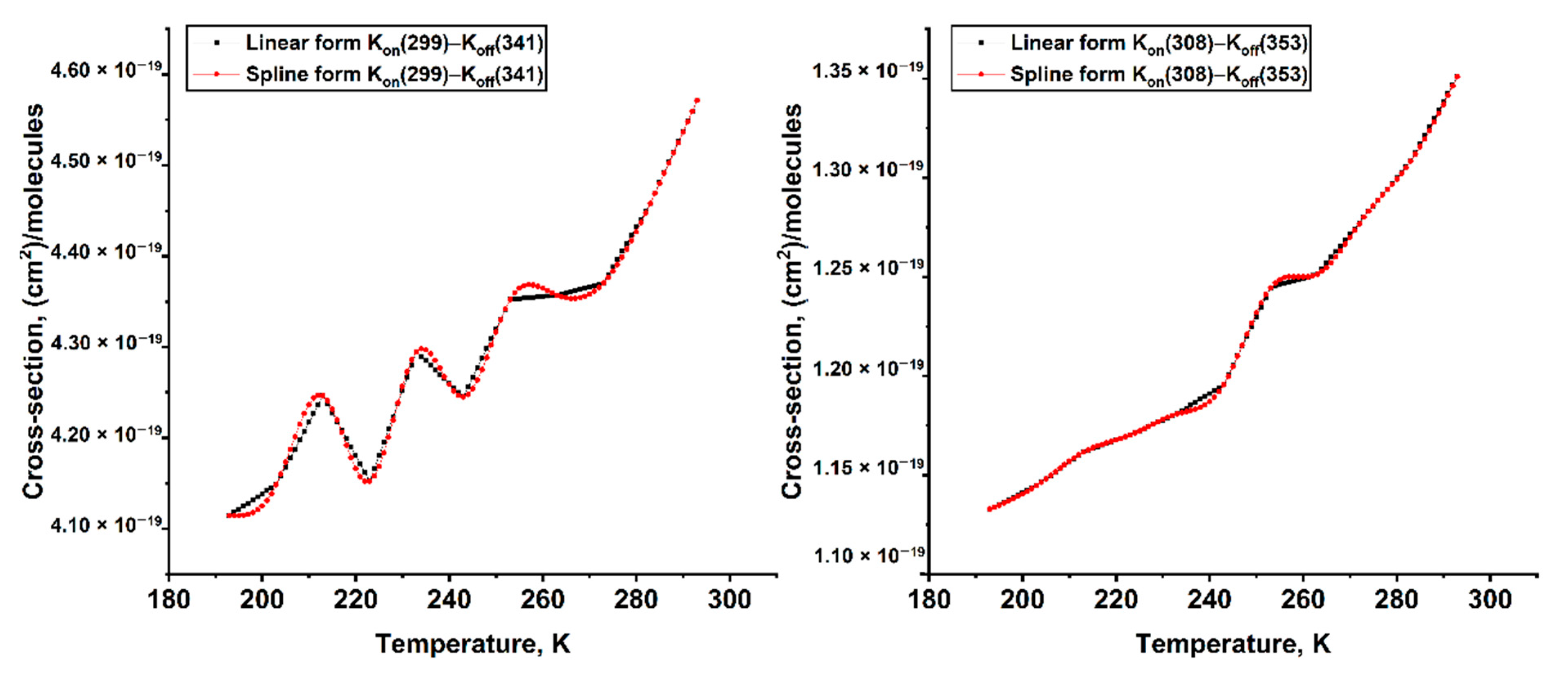
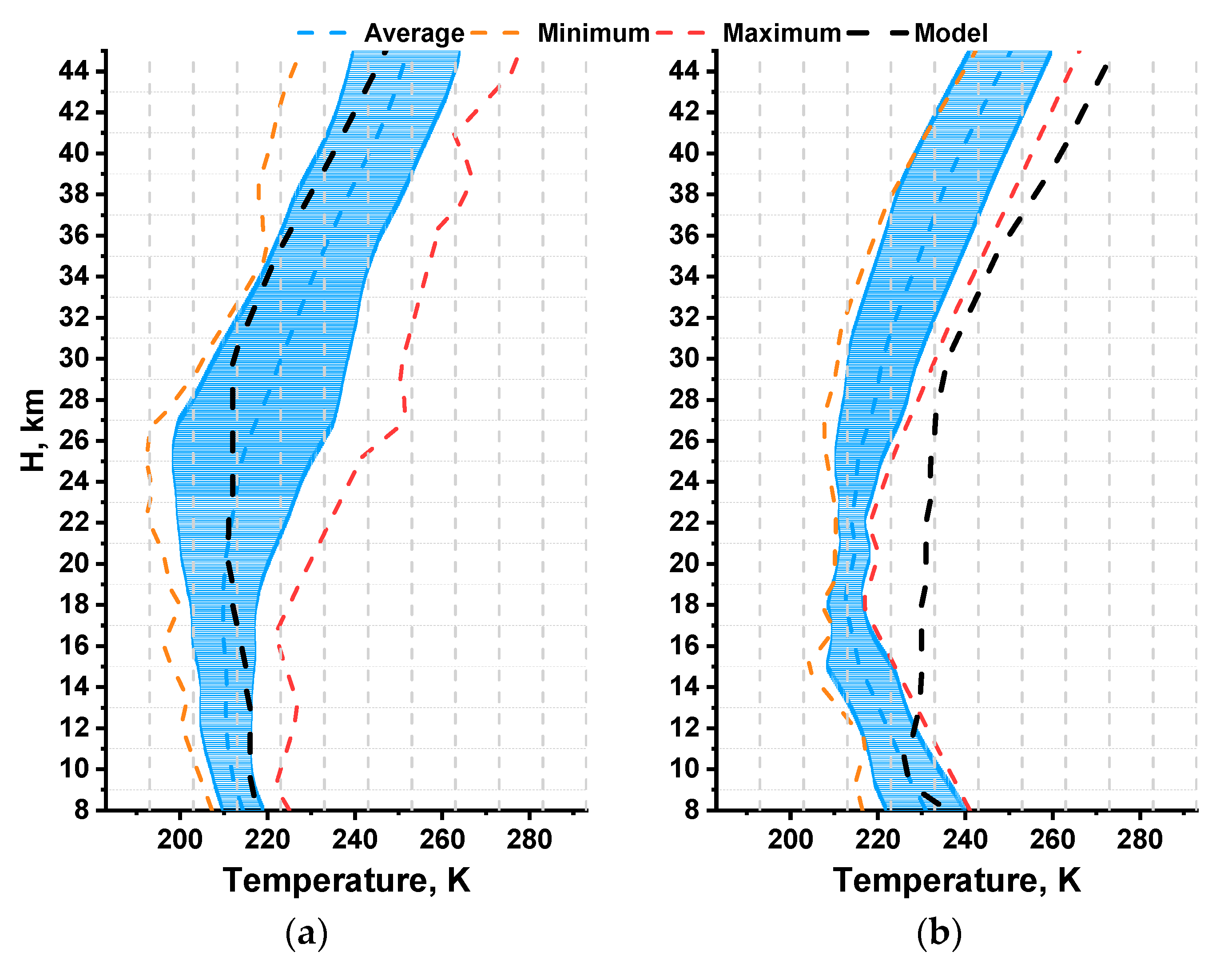
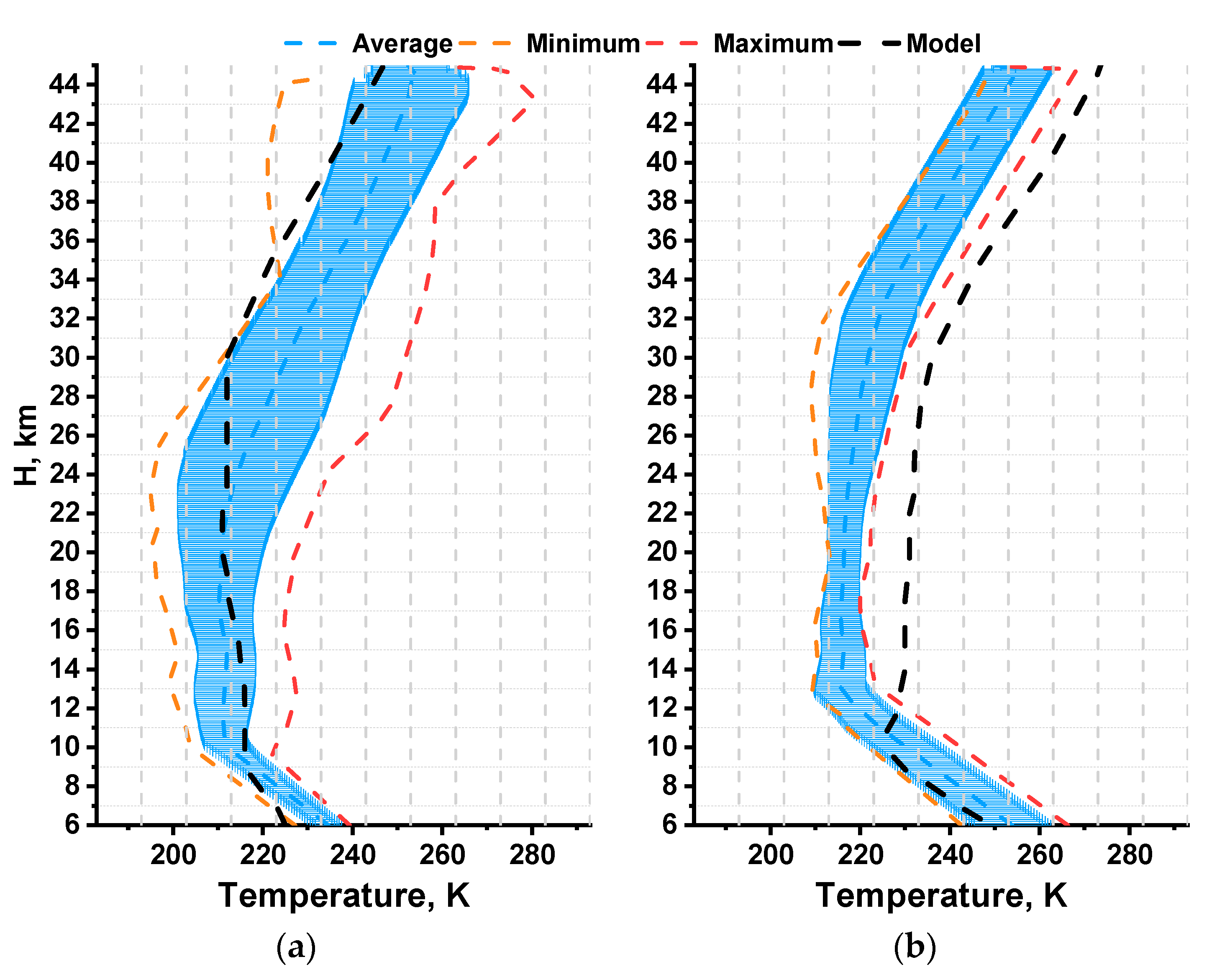
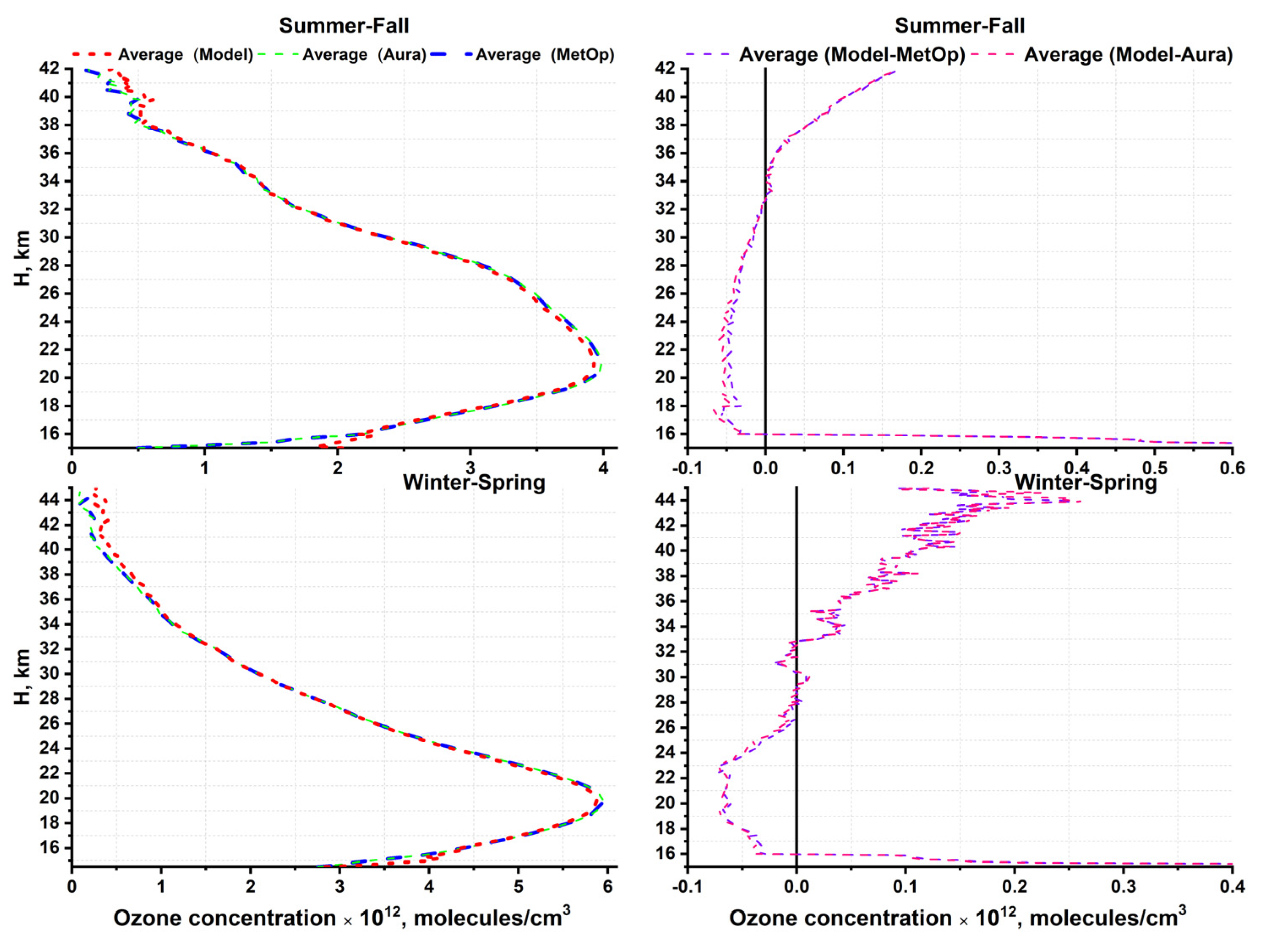
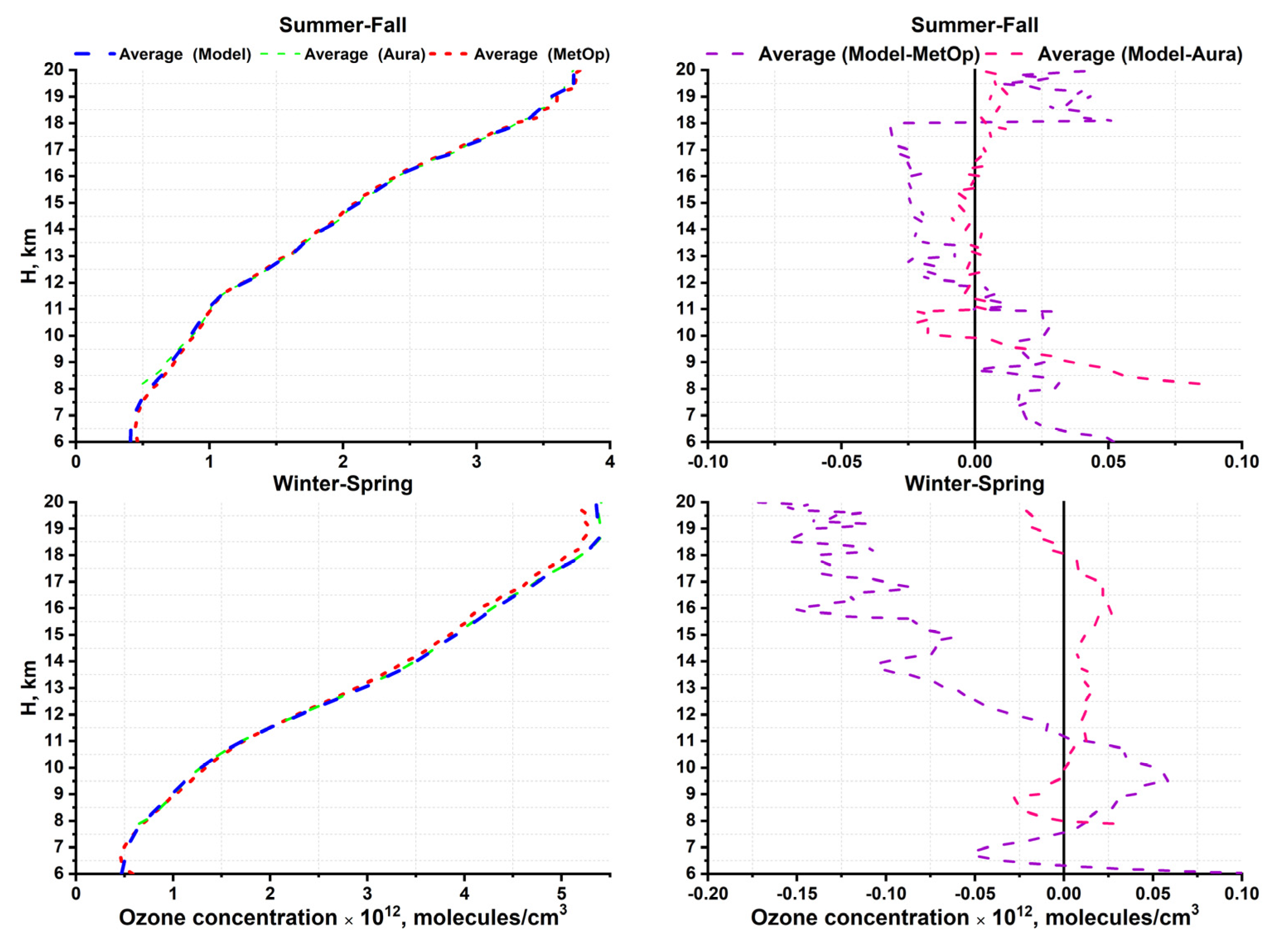
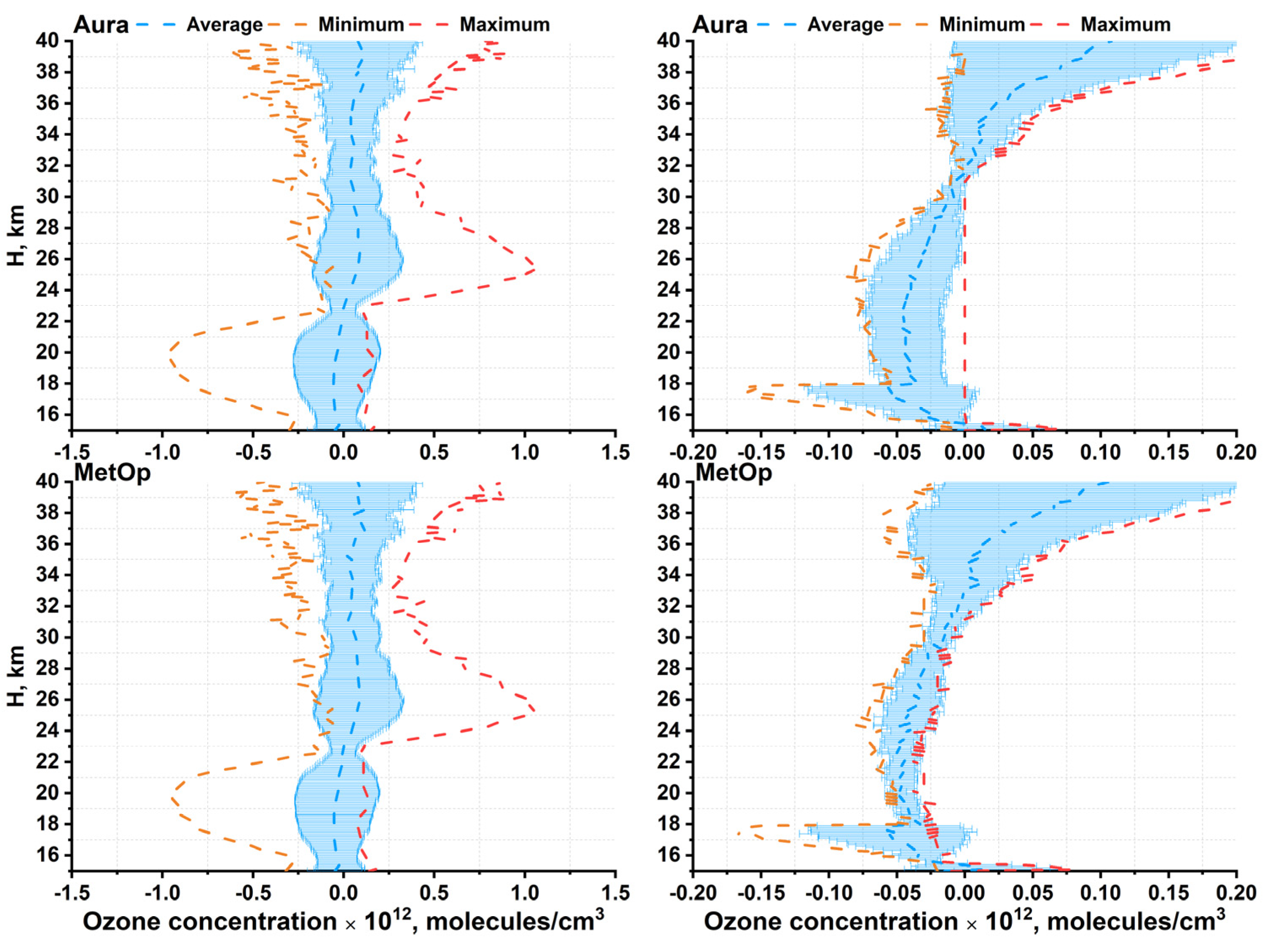
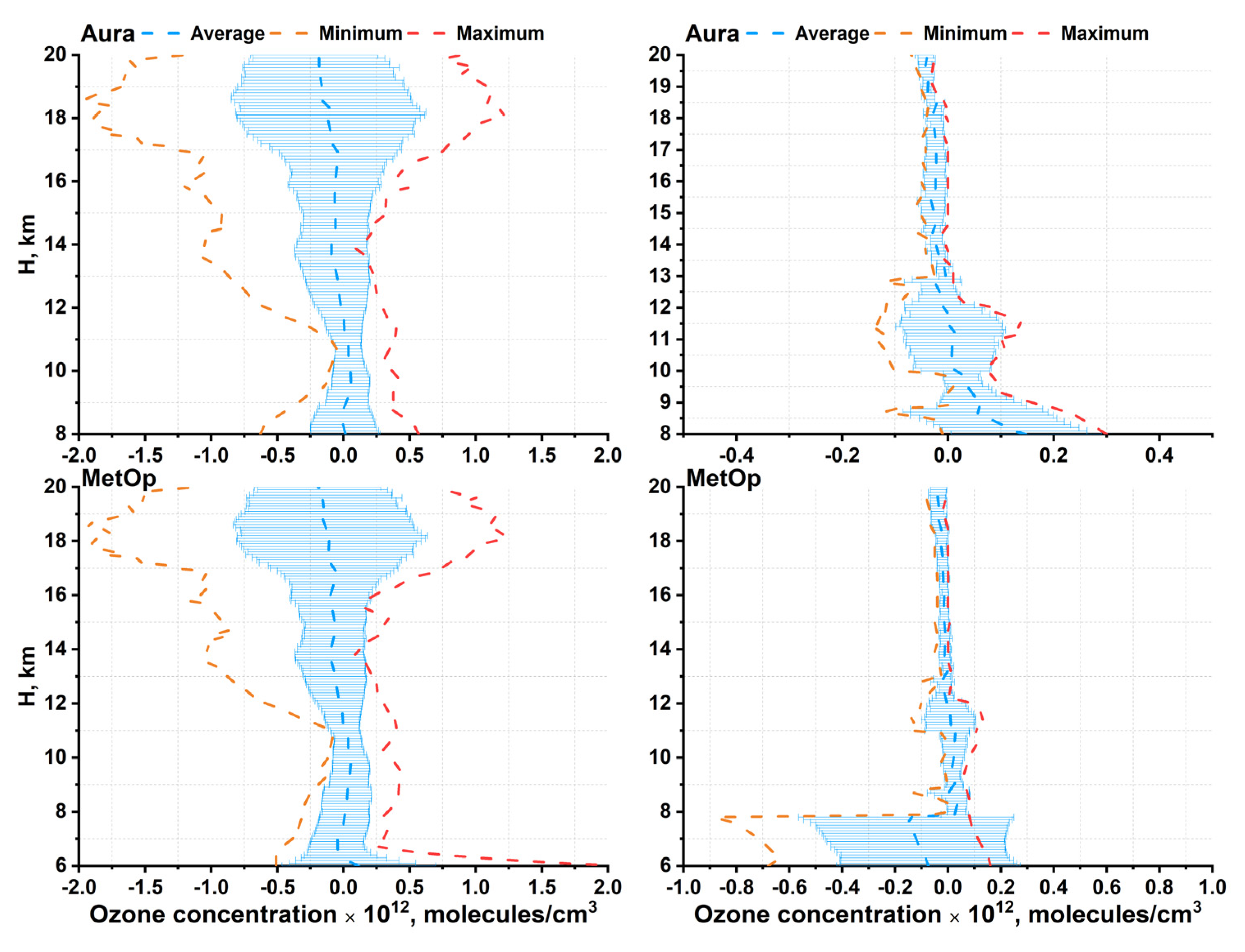
| Wavelength, nm | Temperature, K | ||||||||||
|---|---|---|---|---|---|---|---|---|---|---|---|
| 193 | 203 | 213 | 223 | 233 | 243 | 253 | 263 | 273 | 283 | 293 | |
| Online | |||||||||||
| 299 | 4.12 × 10−19 | 4.15 × 10−19 | 4.25 × 10−19 | 4.15 × 10−19 | 4.3 × 10−19 | 4.25 × 10−19 | 4.36 × 10−19 | 4.36 × 10−19 | 4.38 × 10−19 | 4.46 × 10−19 | 4.58 × 10−19 |
| 308 | 1.13 × 10−19 | 1.14 × 10−19 | 1.16 × 10−19 | 1.17 × 10−19 | 1.18 × 10−19 | 1.19 × 10−19 | 1.24 × 10−19 | 1.25 × 10−19 | 1.28 × 10−19 | 1.31 × 10−19 | 1.35 × 10−19 |
| Offline | |||||||||||
| 341 | 5.62 × 10−22 | 5.94 × 10−22 | 6.1 × 10−22 | 6.95 × 10−22 | 7.05 × 10−22 | 7.59 × 10−22 | 8.15 × 10−22 | 8.9 × 10−22 | 9.9 × 10−22 | 1.08 × 10−21 | 1.15 × 10−21 |
| 353 | 4.95 × 10−23 | 6.4 × 10−23 | 7.25 × 10−23 | 8.88 × 10−23 | 9.57 × 10−23 | 1.1 × 10−22 | 1.27 × 10−22 | 1.45 × 10−22 | 1.67 × 10−22 | 2.02 × 10−22 | 2.38 × 10−22 |
| Troposphere | ||
|---|---|---|
| Difference ×1012 Molecules/cm3 | Difference ×1012 Molecules/cm3 | |
| Aura Temperature | ||
| Winter–Spring | Summer–Fall | |
| Minimum | from −1.95 at 18.6 km to −0.05 at 10.7 km | from −0.15 at 11.4 km to 0.01 at 9.5 km |
| Maximum | from 0.09 at 13.9 km to 1.23 at 18.2 km | from −0.03 at 18.9 km to 0.3 at 8 km |
| Average | from −0.22 at 20 km to 0.05 at 9.8 km | from −0.04 at 19.5 km to 0.14 at 8 km |
| MetOp Temperature | ||
| Winter–Spring | Summer–Fall | |
| Minimum | from −1.95 at 18.6 km to −0.08 at 10.5 km | from −0.88 at 7.8 km to 0 at 8 km |
| Maximum | from 0.07 at 13.9 km to 2.11 at 6 km | from −0.02 at 19.4 km to 0.16 at 6.2 km |
| Average | from −0.19 at 20 km to 0.11 at 6 km | from −0.15 at 7.8 km to 0.03 at 8.3 km |
Publisher’s Note: MDPI stays neutral with regard to jurisdictional claims in published maps and institutional affiliations. |
© 2020 by the authors. Licensee MDPI, Basel, Switzerland. This article is an open access article distributed under the terms and conditions of the Creative Commons Attribution (CC BY) license (http://creativecommons.org/licenses/by/4.0/).
Share and Cite
Dolgii, S.; Nevzorov, A.A.; Nevzorov, A.V.; Gridnev, Y.; Kharchenko, O. Temperature Correction of the Vertical Ozone Distribution Retrieval at the Siberian Lidar Station Using the MetOp and Aura Data. Atmosphere 2020, 11, 1139. https://doi.org/10.3390/atmos11111139
Dolgii S, Nevzorov AA, Nevzorov AV, Gridnev Y, Kharchenko O. Temperature Correction of the Vertical Ozone Distribution Retrieval at the Siberian Lidar Station Using the MetOp and Aura Data. Atmosphere. 2020; 11(11):1139. https://doi.org/10.3390/atmos11111139
Chicago/Turabian StyleDolgii, Sergey, Alexey A. Nevzorov, Alexey V. Nevzorov, Yurii Gridnev, and Olga Kharchenko. 2020. "Temperature Correction of the Vertical Ozone Distribution Retrieval at the Siberian Lidar Station Using the MetOp and Aura Data" Atmosphere 11, no. 11: 1139. https://doi.org/10.3390/atmos11111139




